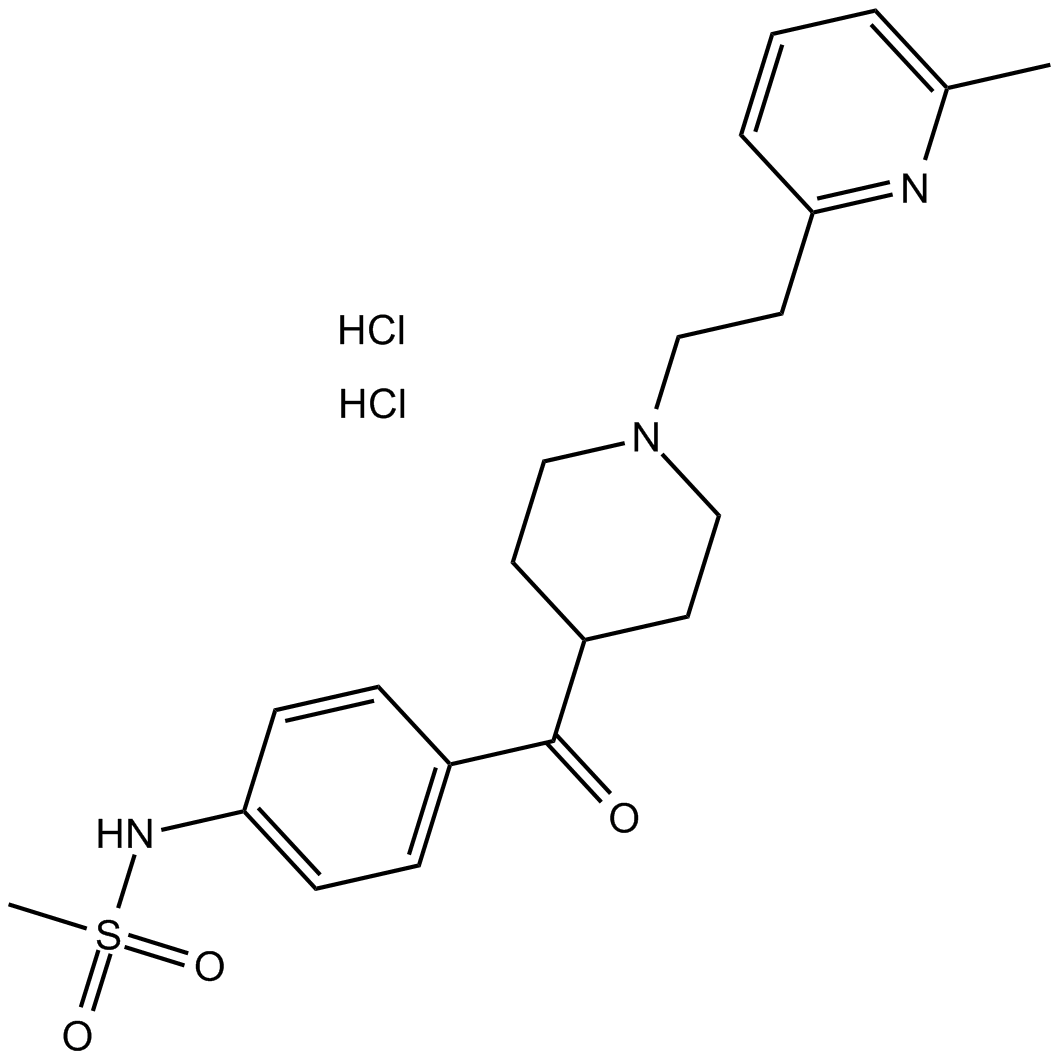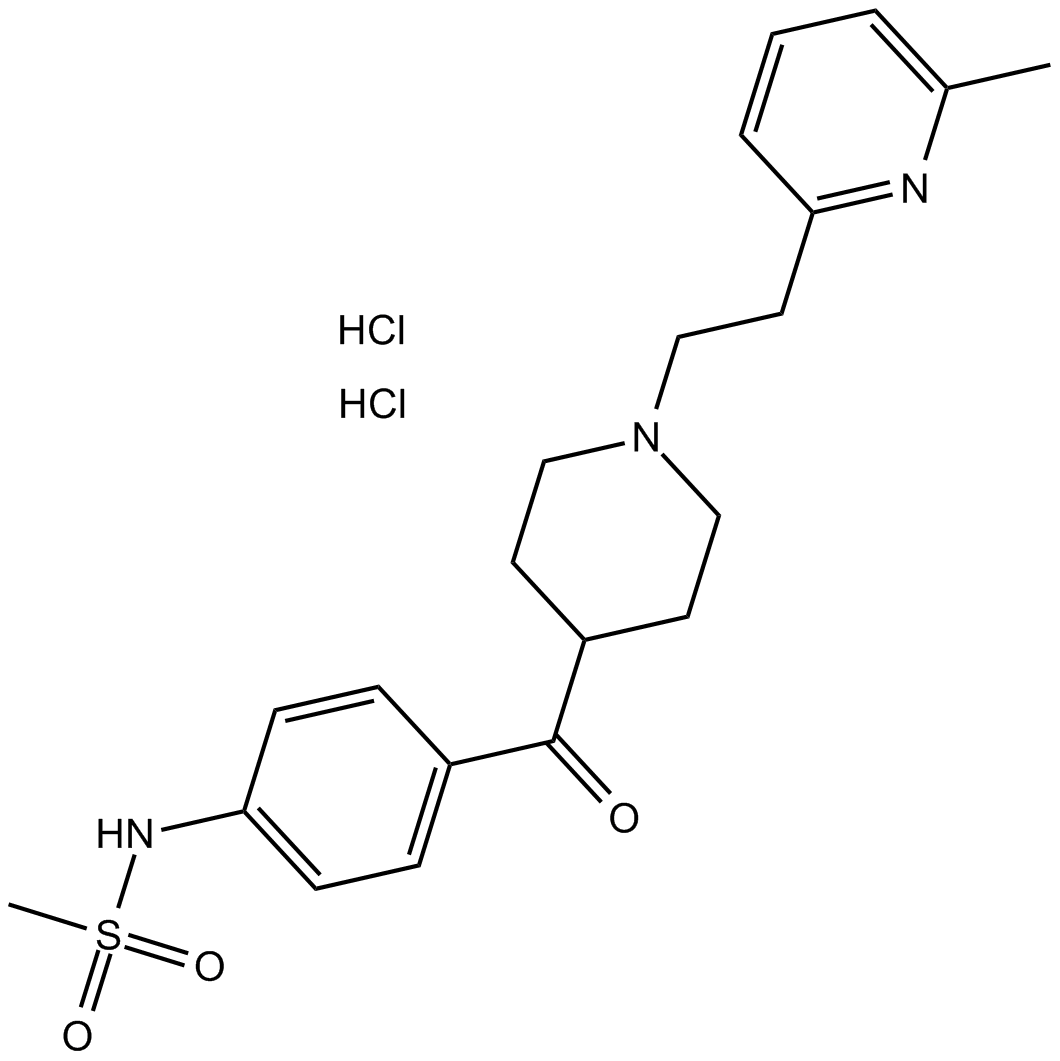E-4031 dihydrochloride
E-4031 dihydrochloride is a methanesulfonanilide class Ⅲ antiarrhythmic agent, capable of prolonging cardiac action potential duration by blocking members of the ether-a-go-go-related gene (ERG) K+ channel family (IC50 = 29 nM). E-4031 dihydrochloride inhibits a variety of ERG isoforms, with KD values being 99, 116 and 193 nM for ERG1, ERG2 and ERG3, respectively. Voltage-gated potassium ERG channels regulate the inwardly rectifying K+ current that repolarizes myocardial cells, gut smooth muscle cells, as well as interstitial cells of Cajal. E-4031 dihydrochloride, as a human ERG (hERG; also known as Kv11.1) K+ channel blocker, has been used to pharmacologically rescue misprocessed hERG mutations in the long QT syndrome type 2.
References:
1. Du LP, Tsai KC, Li MY, et al. The pharmacophore hypotheses of I(Kr) potassium channel blockers: novel class III antiarrhythmic agents. Bioorganic & Medicinal Chemistry Letters, 2004, 14(18): 4771-4777.
2. Shi W, Wymore RS, Wang HS, et al. Identification of two nervous system-specific members of the erg potassium channel gene family. Journal of Neuroscience, 1997, 17(24): 9423-9432.
3. White EJ, Park SJ, Foster JA, et al. Ether-a-go-go-related gene 3 is the main candidate for the E-4031-sensitive potassium current in the pacemaker interstitial cells of Cajal. American Journal of Physiology-Gastrointestinal and Liver Physiology, 2008, 295(4): G691-699.
4. Ficker E, Obejero-Paz CA, Zhao S, et al. The binding site for channel blockers that rescue misprocessed human long QT syndrome type 2 ether-a-gogo-related gene (HERG) mutations. Journal of Biological Chemistry, 2002, 277(7): 4989-4998.
5. Fujiki A. Electrophysiological effects of E-4031, a novel class Ⅲ antiarrhythmic agent. Cardiovascular Drun Reviews, 1994, 12(2): 165-172.
| Physical Appearance | A crystalline solid |
| Storage | Desiccate at RT |
| M.Wt | 474.44 |
| Cas No. | 113559-13-0 |
| Formula | C21H27N3O3S·2HCl |
| Solubility | Soluble in DMSO |
| Chemical Name | N-(4-(1-(2-(6-methylpyridin-2-yl)ethyl)piperidine-4-carbonyl)phenyl)methanesulfonamide dihydrochloride |
| SDF | Download SDF |
| Canonical SMILES | O=C(C(C=C1)=CC=C1NS(=O)(C)=O)C2CCN(CCC3=NC(C)=CC=C3)CC2.Cl.Cl |
| Shipping Condition | Small Molecules with Blue Ice, Modified Nucleotides with Dry Ice. |
| General tips | We do not recommend long-term storage for the solution, please use it up soon. |
| Cell experiment:[3] | |
|
Cell lines |
Mouse small intestine musculature |
|
Reaction Conditions |
1 or 2 μM E-4031 |
|
Applications |
E-4031 induced a significant depolarization of the musculature at 1 μM, probably due to block of ERG channels in smooth muscle cells as well as interstitial cells of Cajal. Further depolarization was seen with 2 μM E-4031. |
| Animal experiment:[5] | |
|
Animal models |
Conscious dogs 3 ~ 5 days after anterior myocardial infarction |
|
Dosage form |
Loading dose 100 μg/kg E-4031 Followed by infusion of 10 μg/kg/min E-4031 |
|
Applications |
E-4031 suppressed the induction of ventricular tachycardia by programmed electrical stimulation. E-4031 protected dogs from the development of ventricular fibrillation within the first hour after the onset of myocardial ischemia in a region remote from the infarcted area. |
|
Note |
The technical data provided above is for reference only. |
|
References: 1. Du LP, Tsai KC, Li MY, et al. The pharmacophore hypotheses of I(Kr) potassium channel blockers: novel class III antiarrhythmic agents. Bioorganic & Medicinal Chemistry Letters, 2004, 14(18): 4771-4777. 2. Shi W, Wymore RS, Wang HS, et al. Identification of two nervous system-specific members of the erg potassium channel gene family. Journal of Neuroscience, 1997, 17(24): 9423-9432. 3. White EJ, Park SJ, Foster JA, et al. Ether-a-go-go-related gene 3 is the main candidate for the E-4031-sensitive potassium current in the pacemaker interstitial cells of Cajal. American Journal of Physiology-Gastrointestinal and Liver Physiology, 2008, 295(4): G691-699. 4. Ficker E, Obejero-Paz CA, Zhao S, et al. The binding site for channel blockers that rescue misprocessed human long QT syndrome type 2 ether-a-gogo-related gene (HERG) mutations. Journal of Biological Chemistry, 2002, 277(7): 4989-4998. 5. Fujiki A. Electrophysiological effects of E-4031, a novel class Ⅲ antiarrhythmic agent. Cardiovascular Drun Reviews, 1994, 12(2): 165-172. |
|
Quality Control & MSDS
- View current batch:
-
Purity = 98.00%
- COA (Certificate Of Analysis)
- MSDS (Material Safety Data Sheet)
Chemical structure








